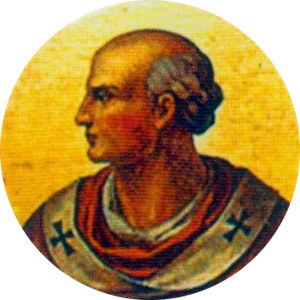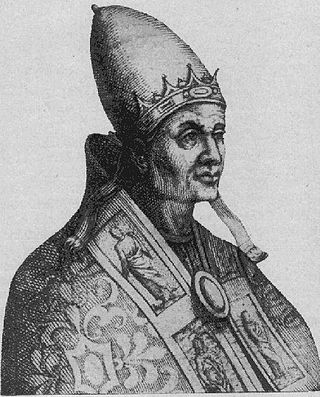Sources
- Caravale, Mario (ed). Dizionario Biografico degli Italiani: L Francesco I Sforza – Gabbi. Rome, 1998.
- Gregorovius, Ferdinand. Rome in the Middle Ages Vol. II. trans. Annie Hamilton. 1905.
Oddone Frangipane (also Oddo or Otto, Latin: Odo Frajapanis [1] ) was a Roman lord and military leader in the service of the Papacy in the 12th century.
He was the son of Leo and grandson of Cencio II of the Frangipani family. Oddone had another brother named Cencio. During the middle of the twelfth century, he was the most influential aristocrat in Rome. His career began sometime around 1130. He supported the legitimate popes and opposed the Ghibellines and their Senate.
His family acquired the fortress of Tusculum from Ptolemy II somehow before December 1152, when he sold his rights over Tusculum to Pope Eugene III. In 1155, he acted on behalf of Adrian IV in negotiations with Frederick Barbarossa. In 1156, he was at Benevento to accept the submission of William I of Sicily to the pope. This submission resulted in the confirmation of the Treaty of Benevento. After the papal election of 7 September 1159, Oddone wrote to Louis VII of France exhorting him to support Alexander III. When Alexander was arrested by supporters of the imperialist Antipope Victor IV, it was Oddone who freed him and sent to safety in Campania.
Oddone took over the military leadership of the city of Rome during the absence of Alexander and even afterwards. His son Leo was captured in battle with the emperor's troops in 1167 and he himself led the largest army of Roman citizens since the days of the Roman Empire into battle at Monte Porzio, where he was defeated by Christian I, Archbishop of Mainz. [2]
In the spring of 1170, Oddone remarried to a woman named Eudoxia, a Byzantine princess. He had a son by her named Emanuele. He died some time not long after.

Pope Alexander III, born Roland, was head of the Catholic Church and ruler of the Papal States from 7 September 1159 until his death in 1181.
Pope Stephen IX was the Bishop of Rome and ruler of the Papal States from 3 August 1057 to his death on 29 March 1058. He was a member of the Ardenne-Verdun family, who ruled the Duchy of Lorraine, and started his ecclesiastical career as a canon in Liège. He was invited to Rome by Pope Leo IX, who made him chancellor in 1051 and one of three legates to Constantinople in 1054. The failure of their negotiations with Patriarch Michael I Cerularius of Constantinople and Archbishop Leo of Ohrid led to the permanent East–West Schism. He continued as chancellor to the next pope, Victor II, and was elected abbot of the Benedictine monastery of Montecassino.
Pope Sergius III was the bishop of Rome and nominal ruler of the Papal States from 29 January 904 to his death. He was pope during a period of violence and disorder in central Italy, when warring aristocratic factions sought to use the material and military resources of the papacy. At the behest of Theophylact I of Tusculum, Sergius seized the papal throne from Antipope Christopher, who in turn had deposed Pope Leo V. Sergius' reign was subsequently marked by Theophylact's influence. As pope, Sergius continued many ecclesiastical controversies of his predecessors, including conflict over Pope Formosus' legacy, annulling all ordinations made by the late pope, and the filioque controversy with eastern patriarchs. His pontificate was similarly marked by temporal conflicts, with Sergius' refusal to crown Berengar I of Italy as Holy Roman Emperor, and his support of Byzantine Emperor Leo VI the Wise's fourth marriage. Sergius also saw the restoration of the Lateran Palace.

Benedict X, born Giovanni, was elected to succeed Pope Stephen IX on 5 April 1058, but was opposed by a rival faction that elected Nicholas II. He fled Rome on 24 January 1059 and is today generally regarded as an antipope.
Pope John XIII was the bishop of Rome and ruler of the Papal States from 1 October 965 to his death. His pontificate was caught up in the continuing conflict between the Holy Roman emperor, Otto I, and the Roman nobility. After long and arduous negotiations, he succeeded in arranging a Byzantine marriage for Otto II, in an effort to legitimize the Ottonian claim to imperial dignity. He also established church hierarchy in Poland and Bohemia.
Pope John X was the bishop of Rome and nominal ruler of the Papal States from March 914 to his death. A candidate of the counts of Tusculum, he attempted to unify Italy under the leadership of Berengar of Friuli, and was instrumental in the defeat of the Saracens at the Battle of Garigliano. He eventually fell out with Marozia, who had him deposed, imprisoned, and finally murdered. John’s pontificate occurred during the period known as the Saeculum obscurum.
Honorius II, born Pietro Cadalo, was an antipope from 1061 to 1072. He was born in the County of Verona, and became bishop of Parma in 1045. He died at Parma in 1072.
Sylvester IV, born Maginulf, was a claimant to the Papacy from 1105 to 1111 in opposition to Paschal II. A priest before his election, he was probably a native of Rome. He had the backing of the Roman militia and initially of the Holy Roman Emperor, Henry IV, who later forced him to abdicate. Today he is regarded as an antipope.
Alberic I was the Lombard Duke of Spoleto from between 896 and 900 until 920, 922, or thereabouts. He was also Margrave of Camerino, and the son-in-law of Theophylact I, Count of Tusculum, the most powerful man in Rome.
Pier Leoni was the son of the Jewish convert Leo de Benedicto and founder of the great and important medieval Roman family of the Pierleoni. He was called the Jewish Crassus by Gregorovius.
Ptolemy I was the count of Tusculum in the first quarter of the twelfth century. He was a son of Gregory III. Peter Pisanus, in his Vita Paschalis II refers to Ptolemy and the abbot of Farfa as the allies of the emperor in the same way that the Saints Peter and Paul were the allies of the pope.
Raino, also Rayno, Ranulf, or Reginulf, was the last count of Tusculum from an unknown date when he was first associated with his elder brother, Jonathan, to his own death. His father, Ptolemy II, died in 1153. His mother was Bertha, illegitimate daughter of Henry V, Holy Roman Emperor.
Christian I (c. 1130 – 23 August 1183), sometimes Christian von Buch, was a German prelate and nobleman. He was Archbishop of Mainz and Archchancellor of Germany from 1165 until his death in 1183. He was originally elected archbishop in 1160 in a disputed election. He served the Emperor Frederick I as a diplomat in Italy on two occasions.
Landulf VI was the last Lombard prince of Benevento. Unlike his predecessors, he never had a chance to rule alone and independent. The principality lost its independence in 1051, at which point Landulf was only co-ruling with his father, Pandulf III.

The Battle of Monte Porzio was fought on 29 May 1167 between the Holy Roman Empire and the Commune of Rome. The communal Roman army, which one historian has called the "greatest army which Rome had sent into the field in centuries", was defeated by the forces of the Emperor Frederick Barbarossa and his local allies, the Counts of Tusculum and the ruler of Albano. Comparing its effect on the city of Rome, one historian has called Monte Porzio the "Cannae of the Middle Ages".
Cencio I Frangipane was a Roman nobleman of the Frangipani family of the latter half of the eleventh century. He was a Roman consul
Cencius II or Cencio II Frangipane was the son of either of Cencio I or of John, a brother of one Leo. He was the principal representative of the Frangipani family of Rome in the early twelfth century.

The Tusculan Papacy was a period of papal history from 1012 to 1048 where three successive relatives of the counts of Tusculum were installed as pope.

Ardicio de Rivoltela was a cardinal of the Roman Catholic Church. He was a native of Piadena (Platina), in the diocese of Cremona in Lombardy. The appellation "de Rivoltela" is mentioned only once, and its significance is unclear.
Theodinus, O.S.B. was a Benedictine monk, and a cardinal of the Roman Catholic Church. He was a native of Arrone, a hilltop town 15 km east of Terni. He became a cardinal priest, and then cardinal bishop of Porto. He served as a papal diplomat, in Normandy, in the Balkans, and in Venice. He participated in the papal elections of 1181 and 1185.